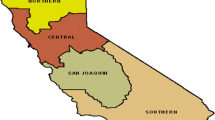Abstract
The objective of this study was to compare feed-forward artificial neural network (ANN) and M5 model tree for estimating reference evapotranspiration (ET0) only on the basis of the remote sensing based surface temperature (Ts) data. The input variables for these models were the daytime surface temperature at the cold pixel obtained from the AVHRR/NOAA sensor and extraterrestrial radiation (Ra). The study has been carried out in five irrigated units that cultivate sugar cane, which located in the Khuzestan plain in the southwest of Iran. A total of 663 images of NOAA–AVHRR level 1b during the period 1999–2009, covering the area of this study were collected from the Satellite Active Archive of NOAA. The FAO-56 Penman–Monteith model was used as a reference model for assessing the performance of the two above approaches. The study demonstrated that modelling of ET0 through the use of M5 model tree gave better estimates than the ANN technique. However, differences with the ANN model are small. Root mean square error and R2 for the comparison between reference and estimated ET0 for the tested data set using the proposed M5 model are 13.7 % and 0.96, respectively. For the ANN model these values are 14.3 % and 0.95, respectively.





Similar content being viewed by others
References
Allen RG, Pereira LS, Raes D, Smith M (1998) Crop evapotranspiration. Guidelines for computing crop water requirements. In: FAO irrigation and drainage paper, no 56. FAO, Roma, Italy
Allen RG, Tasumi M, Trezza R (2007) Satellite-based energy balance for mapping evapotranspiration with internalized calibration (METRIC) – model. J Irrig Drain Eng 133(4):380–394
Bastiaanssen WGM, Menenti M, Feddes RA, Holtslang AA (1998) A remote sensing surface energy balance algorithm for land (SEBAL): 1. Formulation. J Hydrol 212–213:198–212
Bhartiya KM, Ghare AD (2014) Relative humidity based model for estimation of reference evapotranspiration for western plateau and hills region of India. Water Resour Manag 28(10):3355–3364
Bhattacharya B, Solomatine DP (2005) Neural networks and M5 model trees in modeling water level–discharge relationship. Neurocomputing 63:381–396
Caparrini F, Castelli F, Entekhabi D (2004) Estimation of surface turbulent fluxes through assimilation of radiometric surface temperature sequences. J Hydrometeorol 5(1):145–159
Carlson TN, Ripley DA (1997) On the relation between NDVI, fractional vegetation cover, and leaf area index. Remote Sens Environ 62(3):241–252
Cleugh HA, Leuning R, Qiaozhen M, Running SW (2007) Regional evaporation estimates from flux tower and MODIS satellite data. Remote Sens Environ 106:285–304
Crow WT, Kustas WP (2005) Utility of assimilating surface radiometric temperature observations for evaporative fraction and heat transfer coefficient retrieval. Bound-Layer Meteorol 115:105–130
De Vries DA, Birch JW (1961) The modification of climate near the ground by irrigation for pastures on the riverine plain. Aust J Agr Res 12(2):260–272
Debnath S, Adamala S, Raghuwanshi NS (2015) Sensitivity analysis of FAO-56 Penman-Monteith method for different agro-ecological regions of India. Environ Process 2:689–704
French AN, Jacob F, Anderson MC, Kustas WP, Timmermans W, Gieske A, Su Z, Su H, McCabe MF, Li F, Prueger J, Brunsell N (2005) Surface energy fluxes with the Advanced Spaceborne Thermal Emission and Reflection radiometer (ASTER) at the Iowa 2002 SMACEX site (USA). Remote Sens Environ 99:55–65
Hornik K, Stinchcombe M, White H (1989) Multilayer feedforward networks are universal approximators. Neural Netw 2:359–366
Kisi O, Cengiz TM (2013) Fuzzy genetic approach for estimating reference evapotranspiration of Turkey: Mediterranean region. Water Resour Manag 27(10):3541–3553
Kumar M, Raghuwanshi NS, Singh R, Wallender WW, Pruitt WO (2002) Estimating evapotranspiration using artificial neural network. J Irrig Drain Eng 128(4):224–233
Maeda EE, Wiberg DA, Pellikka PK (2011) Estimating reference evapotranspiration using remote sensing and empirical models in a region with limited ground data availability in Kenya. Appl Geogr 31:251–258
Norman JM, Anderson MC, Kustas WP, French AN, Mecikalski J, Torn R, Diak GR, Schmugge TJ, Tanner BCW (2003) Remote sensing of surface energy fluxes at 101-m pixel resolutions. Water Resour Res 39(8):1221. doi:10.1029/2002WR001775
Odhiambo LO, Yoder RE, Hines JW (2001) Optimization of fuzzy evapotranspiration model through neural training with input–output examples. Trans ASAE 44(6):1625–1633
Pal M, Deswal S (2009) M5 model tree based modelling of reference evapotranspiration. Hydrol Process 23:1437–1443
Papadavid G, Hadjimitsis DG, Toulios L, Michaelides S (2013) A modified SEBAL modeling approach for estimating crop evapotranspiration in semi-arid conditions. Water Resour Manag 27(9):3493–3506
Quinlan JR (1992) Learning with continuous classes. In Proceedings of the Fifth Australian Joint Conference on Artificial Intelligence, Hobart, Australia, 16–18 November, World Scientific, Singapore: 343–348
Sobrino JA, Raissouni N (2000) Toward remote sensing methods for land cover dynamic monitoring, application to Morocco. Int J Remote Sens 21(2):353–366
Solomatine DP, Xue Y (2004) M5 model trees compared to neural networks: application to flood forecasting in the upper reach of the Huai River in China. J Hydrol Eng 9(6):491–501
Su Z (2002) The surface energy balance system (SEBS) for estimation of turbulent heat fluxes. Hydrol Earth Syst Sci 6:85–100
Trajkovic S, Kolakovic S (2009) Evaluation of reference evapotranspiration equations under humid conditions. Water Resour Manag 23:3057–3067
Ulivieri C, Castronouvo MM, Francioni R, Cardillo A (1994) A split-window algorithm for estimating land surface temperature from satellites. Adv Space Res 14(3):59–65
Valor E, Caselles V (1996) Mapping land surface emissivity from NDVI: application to European, African and South American areas. Remote Sens Environ 57(3):167–184
Wang Y, Witten IH (1997) Induction of model trees for predicting continuous lasses. In: Proceedings of the Poster Papers of the European Conference on Machine Learning. University of Economics, Faculty of Informatics and Statistics, Prague
Acknowledgments
This study is the partial work under Project No. 88-01-02-054 supported by Khuzestan Water and Power Authority and was done in the Department of Irrigation and Drainage Engineering, Abouraihan Campus, University of Tehran.
Author information
Authors and Affiliations
Corresponding author
Rights and permissions
About this article
Cite this article
Rahimikhoob, A. Comparison of M5 Model Tree and Artificial Neural Network’s Methodologies in Modelling Daily Reference Evapotranspiration from NOAA Satellite Images. Water Resour Manage 30, 3063–3075 (2016). https://doi.org/10.1007/s11269-016-1331-9
Received:
Accepted:
Published:
Issue Date:
DOI: https://doi.org/10.1007/s11269-016-1331-9




